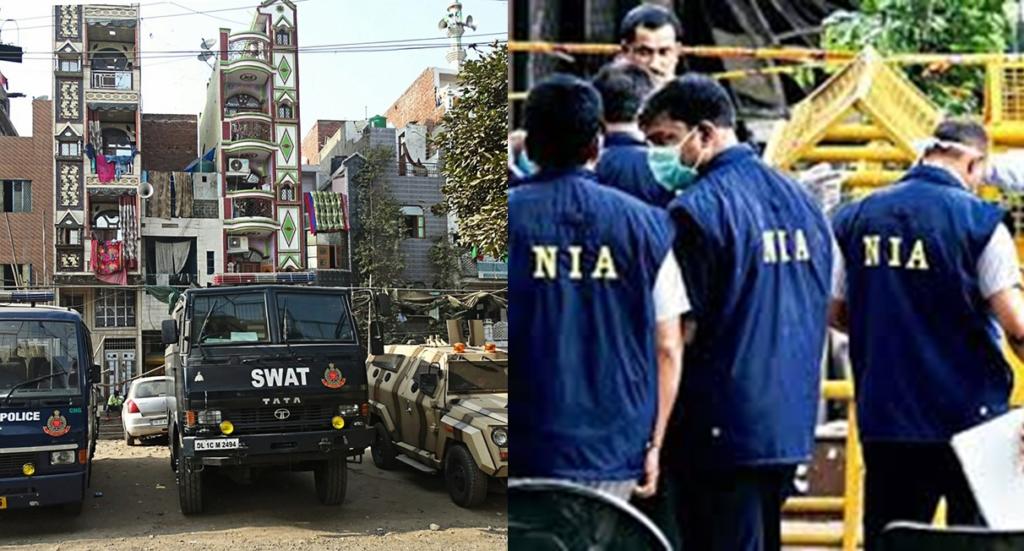In a major development, the NIA conducted raids at 17 locations across Delhi and Uttar Pradesh busting an ISIS module and foiling a terror plot in the process. 10 ISIS suspects have been arrested after the raids. They are suspected of being associated with an ISIS module named, ‘Harkat-ul-Harb-e-Islam’. The NIA stated that the suspected terrorists were planning to carry out terror blasts across northern India, including the national capital Delhi. According to the NIA chief inspector, Alok Mittal, the ISIS module was planning to target the crowded localities and the political personalities. The module was also in contact with a foreign mastermind whose identity has not been confirmed yet. However, the NIA IG added that the accused have been in touch with an international handler and communicating through messaging apps, ‘Telegram’ and ‘Whatsapp’. Moreover, the module is said to have been in the advanced stage of planning as far as conducting the strikes is concerned.
The searches were conducted at Delhi’s Seelampur and Uttar Pradesh’s Lucknow, Amroha and Hapur districts. The agency has reportedly recovered a huge cache of arms and ammunition. The agency said that it recovered explosives and weapons, including a country-made rocket launcher, 112 timers, 12 pistols and 150 rounds of ammunition, from the terror suspects. Apart from this, 120 alarm clocks and batteries along with 25 kilos of explosive chemicals were also found including potassium nitrate, potassium chlorate, sugar paste, and sulphur. Money worth Rs 7.5 lakh, nearly 100 mobile phones and 135 SIM cards, laptops and memory cards have also been recovered. According to the NIA chief, the number of explosives and timers which have been found suggest that the suspected terrorists had planned to make a number of bombs. The NIA IG said that the suspected terrorists had planned to carry out both remote IED (Improvised Explosive Device) attacks, as well as fidayeen (suicide bombing) attacks in the near future. Suicide vests were also seized during the raids conducted by the agency.
Of the arrested persons, 5 suspects have been arrested from the western Uttar Pradesh district of Amroha after a joint operation was carried out by the NIA and the UP Anti-Terrorism Squad. The remaining 5 arrests were made from north-east Delhi in cooperation with the Special Cell of the Delhi Police. The suspected terrorists hail from different backgrounds- one has a welding shop, one is a civil engineer, one is a business student, one has a garment store, while another is a driver. One of the suspects is a female as well. As far as the funding of the module is concerned, the suspects are believed to be largely self-funded. What indicates extreme radicalisation is the fact that the module includes some who robbed gold and jewellery from their houses and sold it to buy materials to make bombs. The suspected terrorists are believed to have been trained locally. As far as communication is concerned, it is said that Whatsapp and Telegram were used for communication. The ISIS module which has been busted was conceived three to four months ago.
In what clearly hints at religious radicalization behind the busted ISIS module, Mufti Sohail, a Maulvi at a mosque in Amroha has been identified as the leader of the module. He is believed to be the mastermind of the gang who is also directing the plot. This makes the religious radicalisation angle totally apparent. The fact that a cleric was not only involved in such activities but also led from the front goes on to show the dangerous form that religious indoctrination and radicalisation can take.
The NIA deserves every bit of applause for busting the module and foiling a major terror bid. By successfully busting this module, the NIA has averted a major threat. But it also shows the need for nipping terrorism in its bud. The authorities and the government must devise a strategy whereby it can strike at the very foundation of terrorism. The way the suspects were being led by a cleric goes on to show the need of checking radical tendencies so that vulnerable elements do not fall prey to religious radicalism.
